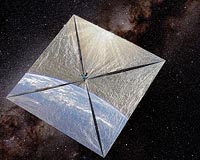 |
Bonn, Germany (SPX) Nov 10, 2009 Outer space, a place of enormous distances: for more than 30 years, unmanned spacecraft have journeyed to learn more about the depths of space, its planets and the nature of interplanetary space. Now, billions of kilometres from Earth, space probes are entering areas never before explored by humankind. At present, four of these space probes, objects created by human endeavours, are the furthest items from Earth ever constructed by mankind. The American probes Pioneer 10 and 11 as well as Voyager 1 and 2 have now passed beyond the orbital path of the last planet in our Solar System and are still travelling ever further from it. The US space probe Pioneer 10, destination Jupiter, took off from Cape Canaveral on 3 March 1973 on board an Atlas-Centaur launch vehicle. On its way to Jupiter, it also examined the asteroid belt and interplanetary space. As planned, it flew past Jupiter and continued sending data to Earth until January 2003. A service life of 21 months was originally planned - and almost 30 years were achieved.
Unmanned spacecraft journey on into interstellar space Like Pioneer 10, Pioneer 11 arrived at the planets so quickly that slowing it down would have required more fuel than either space probe could possibly have launched with in the first place. Their respective launch vehicles accelerated these two probes to such high speeds that, even today, with no additional propulsion, they continue to fly out beyond the Solar System. The Voyager probes constituted a newer generation of space probe, and they were launched in 1977 on board Titan rockets - Voyager 2 on 20 August 1977, taking to the skies 16 days before Voyager 1. Having said that, Voyager 1 blasted off on a shorter flight path to Jupiter, enabling it to overtake Voyager 2 and to become the first of the pair to fly past Jupiter. After Jupiter, Voyager 1 flew on to Saturn, while the orbit chosen for Voyager 2 took it past Saturn, Uranus and Neptune. This made it possible for the first ever close-up photographs of the two outermost planets in the Solar System to be taken. At the present time, the distance between Voyager 1 and the Sun measures about 111 astronomical units. One astronomical unit (AU) equates to the mean distance between the Earth and the Sun, which measures 149.6 million kilometres. Voyager 2 is now at a distance of 90 AU from Earth, Pioneer 10 is at a distance of 99 AUs and Pioneer 11 is at a distance of 79 AUs. The probes are moving away at speeds of between 11.4 and 17.1 kilometres per second. This means that, each year, they are covering between 2.5 and 3.5 times the distance from Earth to the Sun. Share This Article With Planet Earth
Related Links German Aerospace Center (DLR) Space Tourism, Space Transport and Space Exploration News
 Planetary Society To Sail Again With LightSail
Planetary Society To Sail Again With LightSailPasadena CA (SPX) Nov 10, 2009 "We're back!" said Louis Friedman, Executive Director of The Planetary Society. "With an even more ambitious solar sail program than our last venture." The Planetary Society has announced LightSail, a plan to sail a spacecraft on sunlight alone by the end of 2010. The new solar sail project, boosted by a one-million-dollar anonymous donation, was unveiled at an event on Capitol Hill in ... read more |
|
| The content herein, unless otherwise known to be public domain, are Copyright 1995-2009 - SpaceDaily. AFP and UPI Wire Stories are copyright Agence France-Presse and United Press International. ESA Portal Reports are copyright European Space Agency. All NASA sourced material is public domain. Additional copyrights may apply in whole or part to other bona fide parties. Advertising does not imply endorsement,agreement or approval of any opinions, statements or information provided by SpaceDaily on any Web page published or hosted by SpaceDaily. Privacy Statement |